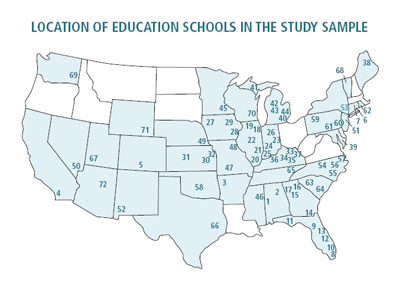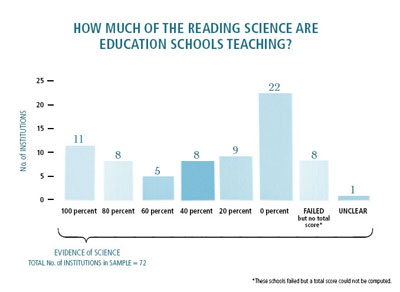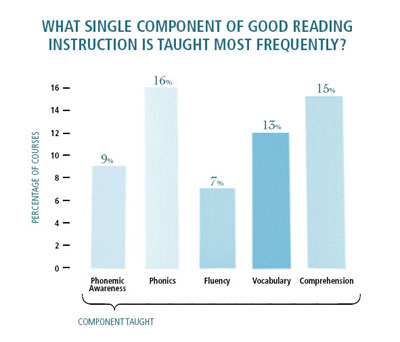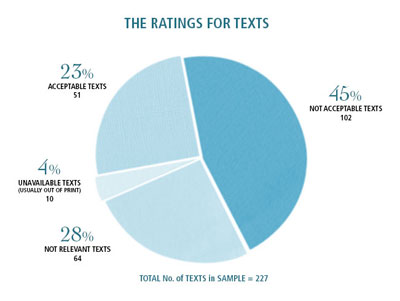Over the last 60 years, scientists from many fields including psychology, linguistics, pediatrics, education, neurobiology, and even engineering have been studying the reading process. This science of reading has led to a number of breakthroughs that can dramatically reduce the number of children destined to become functionally illiterate or barely literate adults. By routinely applying the lessons learned from the scientific findings to the classroom, most reading failure could be avoided. It is estimated that the current failure rate of 20 to 30 percent could be reduced to the range of 2 to 10 percent.
To do so, elementary classrooms must incorporate certain research-based practices, including:
- Early identification of children at risk of reading failure.
- Daily training in linguistic and oral skills to build awareness of speech sounds, or phonemes.
- Explicit instruction in letter sounds, syllables, and words accompanied by explicit instruction in spelling.
- Teaching phonics in the sequence that research has found leads to the least amount of confusion, rather than teaching it in a scattered fashion and only when children encounter difficulty.
- Practicing skills to the point of “automaticity” so that children do not have to think about sounding out a word when they need to focus on meaning.
- Concurrently with all of the above, building comprehension skills and vocabulary knowledge through reading aloud, discussing, and writing about quality children’s literature and nonfiction topics.
- Frequent assessment and instructional adjustments to make sure children are making progress.
Regardless of social class, race, or income, roughly a third of all kindergartners require this explicit, systematic approach to learn how to read.
Over the last few decades, scientists have set out to persuade educators and policymakers of the significance of these findings, urging them to put aside whatever notion they had of how reading should be taught to adopt these practices. Still, the resistance from many educators to change has been palpable.
Given this observed but not well documented resistance, the National Council on Teacher Quality (NCTQ) decided to examine what aspiring elementary teachers are learning about reading instruction during their formal undergraduate training. Accordingly, we undertook a unique effort to evaluate what education schools teach elementary teacher candidates about reading instruction by examining course syllabi and the texts that must be read for these courses.
Our analysis provides a reasonable assessment and the most comprehensive picture to date of what elementary teacher candidates are learning - or failing to learn - about the teaching of reading. In reaching our conclusions, we understand that a course’s intended goals and topics as reflected by syllabi and texts may differ from what actually happens in the classroom. However, it is reasonable to assume that college professors give thought and consideration to their syllabi and course readings, which represent the intended structure of their courses and emphasize what they view as essential knowledge. Typically, the texts they assign capture the universe of knowledge that the professor thinks is important. Less is apt to be covered in class than what the texts contain, not more. Also, a syllabus is more like a restaurant menu: It doesn’t tell diners whether the food or service is any good, but at least they’ll know what’s cooking in the back and whether to prepare their taste buds for a curry or fried chicken.
We randomly selected a sample of 72 elementary education programs that mirror the admissions selectivity of the nation’s 1,271 higher education institutions that house elementary education programs.

Our sample, all randomly selected and representing schools of all types, constitutes 5.6 percent of the institutions that offer elementary teacher certification. We restricted our analysis to:
- Any reading course required of students who aspire to teach kindergarten through fifth grade. Depending on the institution or state, this parameter involved courses leading either to early childhood or elementary certification.
- Required reading courses. We did not analyze elective coursework, as our purpose was to determine the reading instruction that institutions consider essential for aspiring teachers.
Our final sample included 223 required courses. We analyzed each of these courses to assess the degree to which the five components of effective reading instruction are taught: phonemic awareness, phonics, fluency, vocabulary, and comprehension. These are the five necessary components of good reading instruction identified in the review of research by the National Reading Panel report released in 2000. Here are our findings:
Finding No. 1:
Most Education Schools are not teaching the science of reading
Almost all of the 72 institutions in our sample earned a “failing” grade, even though a passing grade was possible if a professor devoted less than 20 percent of the lectures to the science of reading. Institutions could receive a passing score if course materials merely referenced each of the five components of good reading instruction - without our knowing for certain if the science was taught correctly or adequately.
Education schools that provided exposure to all five components received a score of 100 percent, while schools that taught only one out five components received a score of 20 percent. Schools that taught none of the five components received a zero. Some schools failed but their total score could not be computed because of missing or unavailable data.
Even after we set the bar for passing so low, only 11 out of 72 institutions (15 percent) were found to actually teach all the components of the science of reading.
Nearly a third of the institutions make no reference to reading science in any of their reading courses, even though many of these institutions require up to four reading courses.
Table 1 lists the institutions, in alphabetical order within their group ranking.


Finding No. 2:
Even courses claiming to provide a “balanced” approach ignore the science of reading.
The notion of “balanced literacy,” which many institutions claim to promote, was developed in the 1990s. This approach was an effort to retain the best practices of the whole language method (presumably preserving the important role of good literature) while injecting greater emphasis on decoding (phonemic awareness, phonics, and fluency).
However, our analysis of courses revealed that this balance is rarely achieved. We searched our sample of 223 courses for courses that might be described as teaching balanced literacy, identifying 93 that met our criteria. Only 9 percent of this subset devoted lecture time to teaching the science of reading as even one of several approaches that teachers might need to know.
These findings paint a discouraging picture. Almost all of the professors who say their intention is to provide a “balanced” approach never acknowledge that there is a science of reading.
Finding No. 3:
Characteristics such as national accreditation do not increase the likelihood that an education school is more likely than others to teach the science of reading.
We paired the 13 schools in the sample that are not accredited by the National Council for the Accreditation of Teacher Education (NCATE) with 13 other schools in our sample. These 13 pairs are each similar in the number of teachers they produce, the selectivity of the institution, and the reading standards in their states. The NCATE schools do no better than the non-NCATE schools. We examined the schools for correlation on other measures: the number of teachers an institution produces each year, the level of its selectivity, its status as either public or private, and its level of minority enrollment. None of our tests yielded any significant correlations, suggesting that none of these variables make it either more or less likely that an institution will teach the science of reading.
Finding No. 4:
Phonics is taught more frequently than any other component of reading instruction, suggesting that ideological resistance to the “phonics camp” does not fully explain why the science is being ignored.
We also analyzed courses to determine which individual components of good reading instruction (phonemic awareness, phonics, fluency, vocabulary, and comprehension) were taught with the most regularity. Our findings suggest that some college professors may not be teaching the science of reading, not just because they are ideologically opposed to the science, but because they may be reluctant to teach what they themselves do not know.
As evidence of that possibility, NCTQ discovered that the two “newest” components of good reading instruction - phonemic awareness and fluency - were broached in the fewest classes, just one in 20. In contrast, phonics, long the linchpin of reading, was taught in one out of seven classes, with slightly more frequency than comprehension, arguably the hallmark component for the whole language approach. See chart on page nine.
That being said, ideological opposition to the science is by far the most likely reason for its neglect. Six out of seven courses do not even broach phonics, despite its long history as a critical component of reading instruction.

Finding No. 5:
Much of current reading instruction is incompatible with the science.
Many reading teachers and textbooks describe the process of becoming a reader as a natural, organic process, though there is no scientific basis supporting such a view for any child, even for children who seem to find it easy to learn how to read. Many courses indicate that exposing children to literature that speaks to their own experience will spark a natural development of reading skill; the right motivation is sufficient to build skill. However, these assertions are also unsupported by scientific evidence.
Finding No. 6:
Teacher educators portray the science of reading instruction as one approach that is no more valid than others.
The decision about how best to teach reading is repeatedly cast as a personal one, to be decided by the aspiring teacher. All methods are presented as being equally valid, and how one teaches reading is merely a decision about what works best for the individual teacher. An illustrative example makes the point. The course syllabus at a large western state university states: “While all teachers operate under various constraints, you will ultimately develop your own theories about how best to teach reading and writing.” Assertions like this run contrary to what scientific study tells us is best for instruction, but they are not unusual to find in the course syllabi.
Finding No. 7:
Many courses reflect low expectations, with little evidence of college-level work.
Teacher educators make too few demands on their students. Research papers that encourage or require aspiring teachers to present anyone’s perspective other than their own are a rarity. In a randomly selected subsample of 75 syllabi, only eight (11 percent) courses required any sort of research paper. Most writing assignments generally call for the students’ own feelings and observations. The most common assignment is a “literacy memoir,” which asks students to reflect on how they themselves learned to read as young children.
Further, no effort to develop practical application of knowledge is evident. Students rarely have to demonstrate their knowledge by writing and delivering lesson plans that apply the tools of reading instruction in a classroom setting.
Many professors place more emphasis on keeping their courses fun than on learning. This approach results in activities in which students rely on their own devices to teach literacy rather than on learning how to use well-tested, scientifically sound approaches. We found a typical example of this entertainment approach at a mid-Atlantic public university: “After reading the book, design an original cover for it. Construct reading comprehension questions. Make a commercial that convinces others to buy and read the book. Make a diorama of the book.” Too many young teachers are entering the field of teaching having been required to do nothing more sophisticated than the same arts and crafts projects they did as young children.
Finding No. 8:
The quality of almost all reading textbooks is poor. Their content includes little to no hard science, and in far too many cases they are inaccurate and misleading.
Of the 227 texts that were required reading, literacy experts were able to identify only four that would be acceptable as general textbooks for a reading course because they incorporated the science of reading. These four acceptable texts were used in only eleven of 223 courses.

Finding No. 9:
There is no agreement in the field about what constitutes “seminal” texts.
Another problem is fragmentation in the field of reading instruction. In contrast to most other fields, where professionals generally agree on a core of seminal texts, no single reading text, no matter what its approach, was assigned in more than a handful of the courses we examined, and only a tiny fraction of texts were read in more than a single class. Teacher educators clearly have not reached any sort of consensus about a single scholar or text that serves as essential reading in the field. In truth, the field is a free-for-all.

Recommendations
Given the strength of the scientific research in reading instruction, there is genuine cause for concern that only one in seven education schools appears to be teaching elementary teacher candidates the science of reading. Perhaps in 20 years, with some perspective, we will not be surprised to find that it took several decades for the science of reading to be absorbed into mainstream thinking and practice. But that kind of long-term perspective will mean that yet another generation of children will have been deprived of the benefits of the science. Fortunately, there are practical remedies, none of which are excessively complicated or costly. The response falls to no single group but includes states, membership organizations such as NCATE and AACTE, the federal government, textbook publishers, and education schools themselves.
States
States need to develop both strong reading standards and licensing tests based on those standards.
If new teachers were required to pass a stand-alone test in reading instruction as a condition of licensure, school districts could be assured of hiring new teachers who already possess fundamental knowledge of good reading instruction.
Many states lag well behind the federal government’s commitment to reading science. While 29 states require reading courses, many remain silent on what those courses should contain. A reading coursework requirement, while worthwhile, is not as important as articulating strong standards, then backing them up with a test. Together, standards and tests create an effective system of accountability for both education schools and teacher candidates. Massachusetts and Virginia stand out for the quality of their reading tests.
Membership organizations
Education schools that do not teach the science of reading should not be eligible for accreditation.
Accrediting agencies, including the National Council for Accreditation of Teacher Education (NCATE), the Teacher Education Accreditation Council (TEAC), and various regional accrediting bodies, should serve as messengers for reform, but, more importantly, should deny accreditation to schools that do not teach the science of reading.
AACTE needs to be an active champion for the science of reading, providing professional development opportunities for teacher educators to retool their skills.
AACTE can and should shift from its somewhat passive role, in which it does little to dissuade its members from neglecting the reading science, to take on the role of educator and champion for adopting the science.
The Federal Government
- Elementary teachers should be required to pass a test in reading to achieve “highly qualified teacher” status.
- Education schools should be eligible to receive title ii professional development funds to improve faculty expertise in reading.
Given some states’ leisurely efforts in reforming their own approaches to reading, the next reauthorization of No Child Left Behind (anticipated in 2007-08) should require states to include a test of reading knowledge among the tests that are now required of all new elementary teachers. Also, the federal government is currently allocating roughly $3 billion per year through Title II to provide teachers with professional development to meet the goals of No Child Left Behind. Federal funds could be wisely directed toward allowing college faculty members to update their knowledge and skills in reading, as well as toward hiring adjunct professors who are already sufficiently knowledgeable.
Textbook publishers
Publishers need to identify legitimate experts in the field and hire them to develop and write better reading textbooks.
Reading courses for future teachers are dependent upon the ready availability of good texts that provide accurate and comprehensive material. New textbooks that present proven principles of literacy development, why some children have difficulty, and the instructional practices that science has found most effective are desperately needed. Publishers need to identify good authors and content experts in the field who are sufficiently knowledgeable of the science to develop comprehensive textbooks.
Education Schools
Education schools need to build faculty expertise in reading.
Education schools need to acknowledge that they may not have the expertise to deliver coursework that provides a strong grounding in the science of reading. They may need to both hire new faculty members and provide current faculty members with professional development that retools teacher educators across the nation.
As opportunities arise for hiring new faculty members in reading-related fields, education schools need to make reading expertise a priority. Candidates with clearly demonstrated knowledge of the science of reading should be given hiring priority. Only by bringing on new faculty members who are well versed in sound reading instruction and by providing current faculty members with substantive professional development can institutions hope to improve reading instruction for future teachers.
Conclusion
While more research is always needed to improve our understanding of reading (particularly reading comprehension), the issue of what to include in an effective reading instruction course is settled. The question that now must be addressed is: How can we ensure that education programs are effectively teaching future teachers the basic components of reading instruction? Future teachers need the knowledge and skills to understand sound reading strategies for themselves and to be able to transmit these to their students. With the scientific discoveries that began over a half-century ago, we now have the good fortune of holding the keys to the locks that bar far too many children from having full access to society. It is time to put the keys in the locks and start turning them.
For additional copies or the full version of this study, contact:
NATIONAL COUNCIL ON TEACHER QUALITY
1225 19th Street N.W., Suite 800
Washington, D.C. 20036
Tel 202 222-0561 Fax 202 222-0570 Web
www.nctq.org
The National Council on Teacher Quality advocates for reforms in a broad range of teacher policies at the federal, state, and local levels in order to increase the number of effective teachers.
